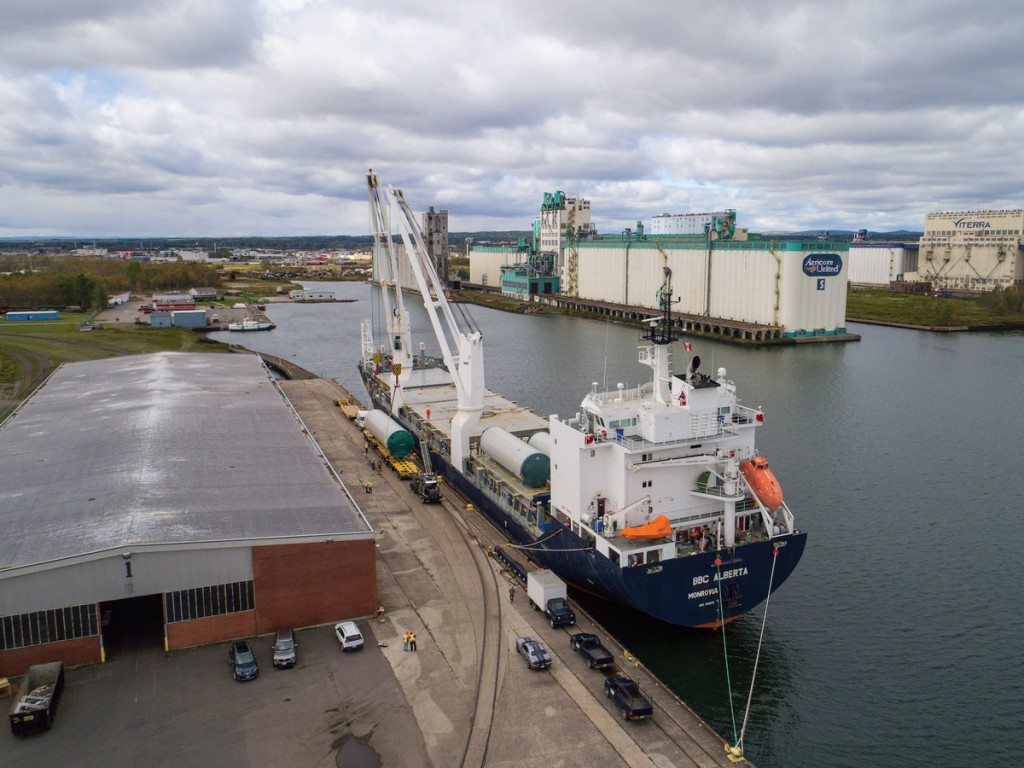
With breakbulk activity already posting robust trends at key Canadian ports, the project cargo outlook is showing evidence of beginning to bounce back from equipment-production delays and other pandemic-related challenges.
The improved project cargo prospects especially apply to wind energy projects where Ontario, Quebec and Alberta currently dominate installed capacity. Earlier this year, the Canadian Renewable Energy Association noted that despite COVID-19 Canada ended 2020 with total wind capacity of 13,588 MW and predicted the construction of 745 MW of additional capacity in 2021.
“Various wind projects went on hold in 2020 because of the pandemic, but the project line-up is picking up this fall,” indicated Chris Heikkinen, Director of Business Development for the Thunder Bay Port Authority. “A number of heavy lifts of the modular type are on the books.”
A lot of construction will be ramping up which heralds strong project cargo business in 2022 and beyond, Mr. Heikkinen suggested.
In August, Keefer Terminal handled its largest shipment of European steel rail to date. Steel imports, which began six years ago at Keefer, are expected to double in 2021 over last year as demand continues in Western Canada.
Steel is also the big story on the St. Lawrence Seaway linking the Atlantic Ocean to the industrial heartland of North America. In the period to August 31, general cargo shipments via the Seaway surged by 60% from a year earlier – mainly due to steel imports from Europe to centers throughout Ontario and U.S. Great Lakes states.
“The demand for steel and construction materials are a reflection of recovering industries domestically and internationally,” comments Terence Bowles, President and CEO of the St. Lawrence Seaway Management Corporation. “These raw materials will be needed for months to come.”
Commenting in similar terms on the above trends Matthew McPhail, vice-president, sales and marketing of Federal Marine Terminals, evoked “a very strong 2021” for FMT.
“We have been able to navigate the global pandemic quite well, with minimal impact on our overall operations,” he said, adding: “In the Great Lakes, steel volumes are quite robust, covering various products by vessel and barge. We have also seen the continuation of wind projects and other project cargoes.”
On the West Coast, breakbulk is also significantly on the rise at Vancouver, Canada’s largest port, with first quarter volume up by nearly 50% at 4.9 million metric tons.
The Port of Vancouver acts as a major consolidation centre in the Pacific Northwest for breakbulk cargo such as forest products, steel and machinery. Breakbulk is handled through one of two terminals - DP World Fraser Surrey and Lynnterm operated by Western Stevedoring.
Two Forwarder Viewpoints of the Pandemic Challenges
Jan-Ludwig Beringer, founder and President of Calgary-based Rohde & Liesenfeld Canada Inc. and Guy Tombs, President of Montreal-based Guy Tombs Limited, international freight forwarder and ship broker offered their insights of project forwarding in Canada during this pandemic era.
Jan-Ludwig Beringer, said of the situation: “The post pandemic challenges in the supply chain are effecting everything they (freight forwarders) do, from how they conduct business (remote workforce versus office based work force), how they communicate with clients (video conferencing instead of travel and face to face meetings), how they rewrite decades old contracts and pricing agreements (eliminating any and all references to delivery deadlines and late delivery penalties, striking out fixed pricing schedules and replacing them with cost-plus and incentive based pricing agreements) and implanting logistics expertise into companies who are struggling with their own in-house logistics to find solutions.

“We are finding more and more projects owners and major corporations are willing to explore new ways of contracting with us and paying for our expertise as project freight forwarders in helping them overcome the current challenges of logistics movements for their projects and overall supply chains. We find ourselves no longer competing for business based on price, but rather on what solutions and logistics support we can provide, irrespective of the price. The project business sectors we are most involved with currently are Mining, Power, LNG and Port Infrastructure.”
Guy Tombs explained that some of the pandemic impacts are beyond the control of the forwarder: “At a Québec port we were advised the day before our vessel arrived there were no healthy crane operators to discharge the vessel the next day. All the qualified local crane operators had COVID-19 or COVID-19 symptoms. The expected big impacts for us were: a vessel on demurrage and a lot of truck waiting time. However, the stevedoring company worked hard and, happily for us, they found a qualified crane operator within several hours.

“There has been congestion at Long Beach, California for months – this has repercussions. The ocean carriers do not always know when their nominated berth is going to be free. For exports of some sensitive cargoes this may mean that the trucks cannot deliver to the port until just before the ship is in. That can represent a lot of truck waiting time costs. The opposite can also apply, where the ship operator is pessimistic about when their ship can dock – and they are surprised to get in earlier and we are not updated until very late in the day, and hence miss the ship.
“Early in the pandemic, when we were in lockdown and working from home week after week I thought, ‘Thankfully we have many good agents overseas.’ Our concept has always been to be on-site for large cargoes at the key intermodal points in Canada, the USA or overseas – but now this was not possible. What we and many others have discovered was that conceptual ability and reliable connections were more important than being on-site, for now. Of course, a good internet connection was vital. “The enduring power of the imagination and guts, basic human qualities, can save the day.”






